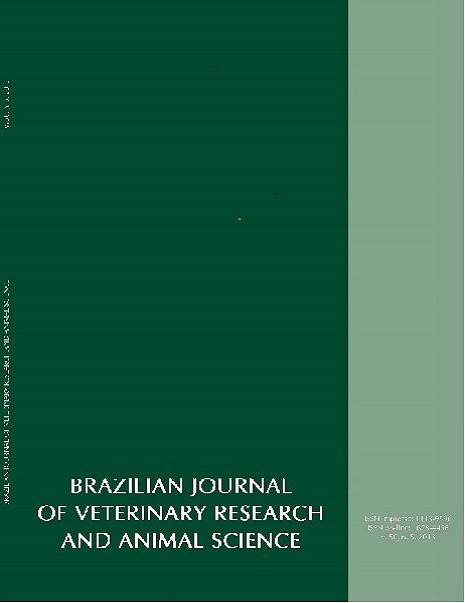Toxoplasma gondii: evaluation of immunofluorescence assay using heterologous secondary antibody in experimentally infected wild small rodents
DOI:
https://doi.org/10.11606/issn.2318-3659.v50i5p353-358Keywords:
Rodents, Toxoplasma gondii, Serological diagnosis, IFAT, MATAbstract
Toxoplasmosis is a zoonotic infection caused by Toxoplasma gondii that affects a wide range of vertebrates. Rodents are intermediate hosts and serve as food for felids, the definitive hosts. However, because of the high variety of species in the order Rodentia, the serological diagnosis is difficult to perform, since the most used techniques require the use of specific antibody conjugated to fluorescein or enzymes. The aim of this study was to evaluate the use of a heterologous secondary antibody conjugate in Immunofluorescence Antibody Test (IFAT) for diagnosis of anti-T. gondii antibodies in two species of wild rodents: Euryoryzomys russatus (WAGNER, 1848) and Calomys callosus (RENGGER, 1830). The specie Mus musculus (Linnaeus, 1758) was used as control conjugate. The animals were experimentally infected with five cysts of T. gondii (strain ME 49) per animal. The Modified Agglutination Test (MAT), which does not require the use of conjugates, and the presence of T. gondii cysts in the rodents were used to confirm the infection. For each animal species, serum samples were collected weekly for five weeks and tested (50 samples per rodent specie, total of 150 samples). None of the samples from C. callosus and E. russatus were positive in the IFAT when anti-mouse heterologous conjugate was used. Brain cysts of T. gondii were microscopically observed in all animals, except in one of the E. russatus. Positive results were found in the MAT 14 days after T. gondii infection in all three species of rodents and IFAT of the control group (M. musculus) was also positive 14 days after infection using anti-mouse (homologous) conjugate. The use of heterologous secondary antibody conjugates should be used with caution and the MAT had a good agreement for serological diagnosis of T. gondii in the studied rodent species.Downloads
Downloads
Published
2013-10-29
Issue
Section
ARTICLES
License
The journal content is authorized under the Creative Commons BY-NC-SA license (summary of the license: https://
How to Cite
1.
Fournier GF da SR, Silva JIG da, Cabral AD, Pena HF de J, Gennari SM. Toxoplasma gondii: evaluation of immunofluorescence assay using heterologous secondary antibody in experimentally infected wild small rodents. Braz. J. Vet. Res. Anim. Sci. [Internet]. 2013 Oct. 29 [cited 2025 Apr. 3];50(5):353-8. Available from: https://revistas.usp.br/bjvras/article/view/79922





